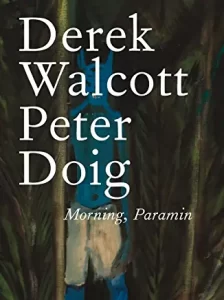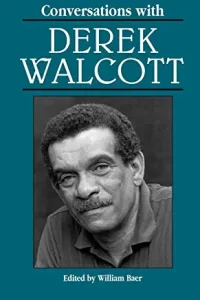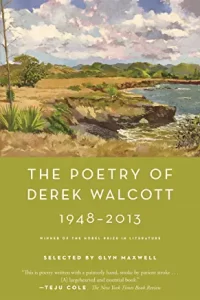|
Getting your Trinity Audio player ready...
|
Reading Time 6 mins
January 23, 2023
“It is a country full of printable names: Paramin, Fyzabad, Couva, where the trees rhyme.”
Bemoaning calypsonians’ facility in using language to conjure imagery, the Mighty Conqueror, in one of his classics, heckled those calypsonians [who] can only sing about a mango if they have the seed to show the audience. In Morning, Paramin, where art emotes and serves as the
about a mango if they have the seed to show the audience. In Morning, Paramin, where art emotes and serves as the  springboard for poems, Derek Walcott turns Conqueror’s banter on its head. In this offering, he constructs verse after canto that does not merely mimic but extends and reimages Peter Doig’s paintings as rhyme and picture complement each other on opposite pages of this masterfully crafted book— a grand celebration of Doig’s paintings and Walcott’s craft. Throughout its 103 pages of painting and corresponding interpretation, there’s a fascination with the everyday and Caribbean landscape.
springboard for poems, Derek Walcott turns Conqueror’s banter on its head. In this offering, he constructs verse after canto that does not merely mimic but extends and reimages Peter Doig’s paintings as rhyme and picture complement each other on opposite pages of this masterfully crafted book— a grand celebration of Doig’s paintings and Walcott’s craft. Throughout its 103 pages of painting and corresponding interpretation, there’s a fascination with the everyday and Caribbean landscape.
In an early poem, Another Life—published, in 1973, when his fellow traveler was 14—Walcott, showing reverence for the Saint Lucian scenery, offered,
We would never leave this island
until we had put down
in paint, in words…
every self-pitying inlet.
Indeed, Walcott has imagined and written broadly and sensitively about almost every facet of Caribbean Civilization, especially in this, his latest offering, which may well have served as the coda.
Still, Morning, Paramin reads as a muted panegyric to Trinidad. On this island, both contributors spent large chunks of their lives: Walcott, from the 1950s to the late 1970s, founded the Trinidad Theatre Workshop (TTW) Workshop, which Professor Rex Nettleford called “The Flagship of the Theatre Movement in the Caribbean.” And Doig, the renowned Scottish-born figurative painter, who spent five of his pre-teen years in Trinidad and relocated there in 2002 to paint and, as Walcott, in Peter I’m Glad You Asked me Along, wonders aloud while absorbing Doig’s alluringly titled portrait, House of Flowers (See You There),
Will your brush pick up an accent and singsong
infect your melody concealed in a canvas
picking the place where you really belong
in Trinidad and all that bullshit that goes with it?
Since Walcott was appraising a 2009 painting, he may have been positing a counterfactual well aware of the painter having cast his studio in Laventille, a setting not that averse to balderdash—and one that harbors multiple inflections. In this alluring text, Doig paints places—some obscure–into popular imagination and history while Walcott refashions and affirms them in verse, thus extending their life. As in Lapeyrouse Wall, the poet inscribes:
Along the cemetery wall of Lapeyrouse
in Port of Spain, Trinidad, he saw this truth
a fellow walking with a floral umbrella
that seems both parasol and parachute.
In Walcott’s eyes and ears, “… the painting is in dialect.” What a sublime representation of this minimalist piece! Fifty pages later, we encounter Lapeyrouse Umbrella,
where headstones multiply like sails on Sunday
where a widower tacks under a pink parasol
where people think pain or pan is good for the soul.
In an implicit glance at a loss, the poet’s words remind of the African proverb, “The dead only die when the living forgets them,” while underscoring pan’s inventiveness and how it lifts the spirit.
From his early beginnings in Saint Lucia, Walcott has looked out and up-ward yet always grounded in his native land, which provided grist for his early exploration of the vestiges of empire, landscape, and life. Most tellingly, as a 14-year-old student, he challenged the unholy Trinity of Church, State, and Empire/Pretense in his, first published poem, “1944″–which provides a portrait of a teen as an artist—as he may well have been unwittingly recasting James Joyce’s missive into, We have too much God in St. Lucia. Privileging a fascination with the woods and landscape, even animals, as a pathway to solace and discernment—even transcendence—”1944″, announcing the onset of his literary pilgrimage to self-knowledge, was denounced by a Catholic priest as sacrilegious.
Not daunted by the early criticism, Walcott soldiered on in his (pre)occupation documenting and historicizing the people while sometimes anthropomorphizing the landscape—“the trees rhyme”–as witnessed in his deft language usage that encases everything Caribbean–from the hills to the seas–in life and feelings. Indeed, in What the Twilight Says: An Overture (1970), he compelled us to see art/theatre in everyday life so that we’d be ready “to transform the theatrical into theatre.”
Paramin invokes Jouvay—street theatre bar none– when blue devils descend in darkness from the picturesque village of Paramin, sequestered in the hilly Northern Range, to break open and light up carnival festivities in the city–Jouvay! Riffing off a stunning Doig painting, ambiguously titled “Untitled (Jungle Painting),” Walcott recalls his late wife,
She loved to say it, and I loved to hear it
‘Paramin, it had the sense of cocoa in it…
as if some deep, deep secret was hidden there.
This poem memorializing his late wife also foreshadows, “when I join her, it will be Paramin for both of us.” Viewing the portrait without the words, one may not arrive at Walcott’s reading; yet, his evocative interpretation works in that his ode unravels and extends the image on the page while connecting it to the serenity of the painter’s present abode — Paramin. Resisting the urge to wonder about the painter’s motivation that gave rise to this stunning piece, contentment is found in Walcott’s acuity as heralded in the epigraph.
Suppose the visual representation of villages, backwaters, the beach, and even ‘pan’ and ‘clubs’ that Doig encountered and fashioned on his canvas is exquisite. In that case, Walcott allows them to speak to us sometimes with eloquence and other times by eliciting wonderment at his discernment. The fascination with landscape and deft representation, both in images and words, floods the collection. We meet, up close, many place names and other cultural markers in Doig’s titles: Carrera, Maracas, San Juan, Grand Riviere, Moruga, and Pure Chutney, all evocatively captured and sometimes decontextualized, even given new flight, in the poet’s framing.
In addition, we encounter six variations on Santa Cruz. Capturing the storm raging on the canvas in Santa Cruz, the poet intones, “…Nature’s tyranny must be obeyed.” And in Santa Cruz II, the poet extrapolates,
The church is closed, but all its shuttered pews
mutter the name: La Divina Pastora….
Connecting “snowy Edmonton”—where Doig spent much of his youth–to Santa Cruz III, Walcott opines,
I lifted the pen up, and it began to sing,
and snow began to powder everything,
celebrating a friendship fused thru “Art,” which “can make us love two countries with one heart/ not separately either, but blent.” Reinserting the painter into the portrait and revealing their deep connection, Walcott affirms that “his daughters have become friends of my own.” All this from canvas?
Throughout, Walcott is methodological in examining Doig’s paintings, often finding the correct word/phrase to capture and extend every crevice, thereby facilitating not ‘a dance of doubt’ but a dance around the dialectic of paintings and interpretations. Oftentimes one can’t help but wonder which came first, art or text. Continuity, then, rather than discontinuity, is the overarching frame of Morning Paramin.
Indeed, the less abstract painting Stag reveals a slightly bent-over figure from whom, with a tinge of irony, Walcott imagines him saying,
Either me or this tree go fall
or both o’ we.
Is not a tree but a lamppost anyway.
What apt extrapolation from the silent frame with the former teetotaler emerging at daybreak into a Metropolitan–(Walcott’s title for the piece)–city evidently, as the poet hears him, “drunk with an accent.” If not contesting, Sparrow’s “Rum is Macho” or even “Drunk and Disorderly” in foregrounding everyman’s hobble—as he may have arisen as an ole mas character–the poet avers,
‘If you are drunk, stay drunk’?
especially on Stag, the loveliest beer…
affirming Sparrow’s take on “Stag,” “no other beer tastes better.” Doig didn’t insert a Stag bottle in the painting. Interestingly, there’s a Stag 35 pages later in Doig’s “Untitled” transformed by Walcott as “The Tanker”—allowing him to read the painting and conjure its “Full Extreme” in “Metropolitan/Stag.” Imbuing Stag with so much spirit, the poet ends, tipping his hat to the evergreen calypsonian, the Mighty Spoiler, by samplin’ his signature refrain, “I feel to fall!”
Perhaps the most intriguing aspect of the collaboration is the occasional mock dueling of word and image, as in “Maracas,” a scene from which Walcott extracts,
I should like to be a guest
at my own funeral, its premise is fun
not in the actual ceremony but the aura
that surrounds it…”
And, with that, Walcott rests–his case.
- A slightly different version of this review appeared in Everybody’s, May 2017.
W.R. (troppy) Holder is a founding member of the Caribbean Awareness Committee (N.Y.), co-editor of BigDrumNation, and the author of Classroom Calypso: Giving Voice to the Voiceless.

Man, Winthrop Holder always informs, connects, uplifts with a tsunami of sounds and ideas, not unlike a John Coltrane solo. Write on, Brother!